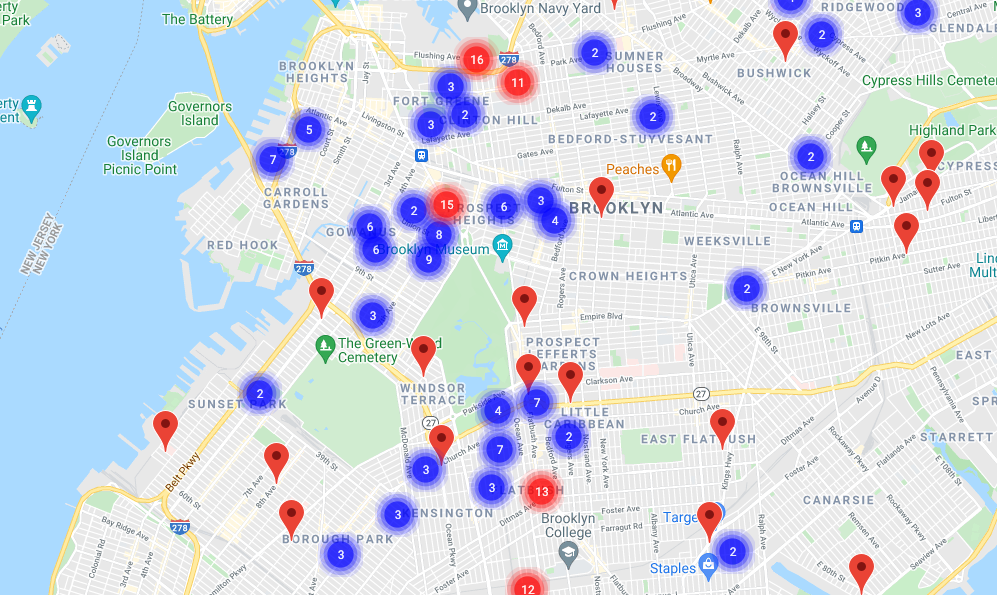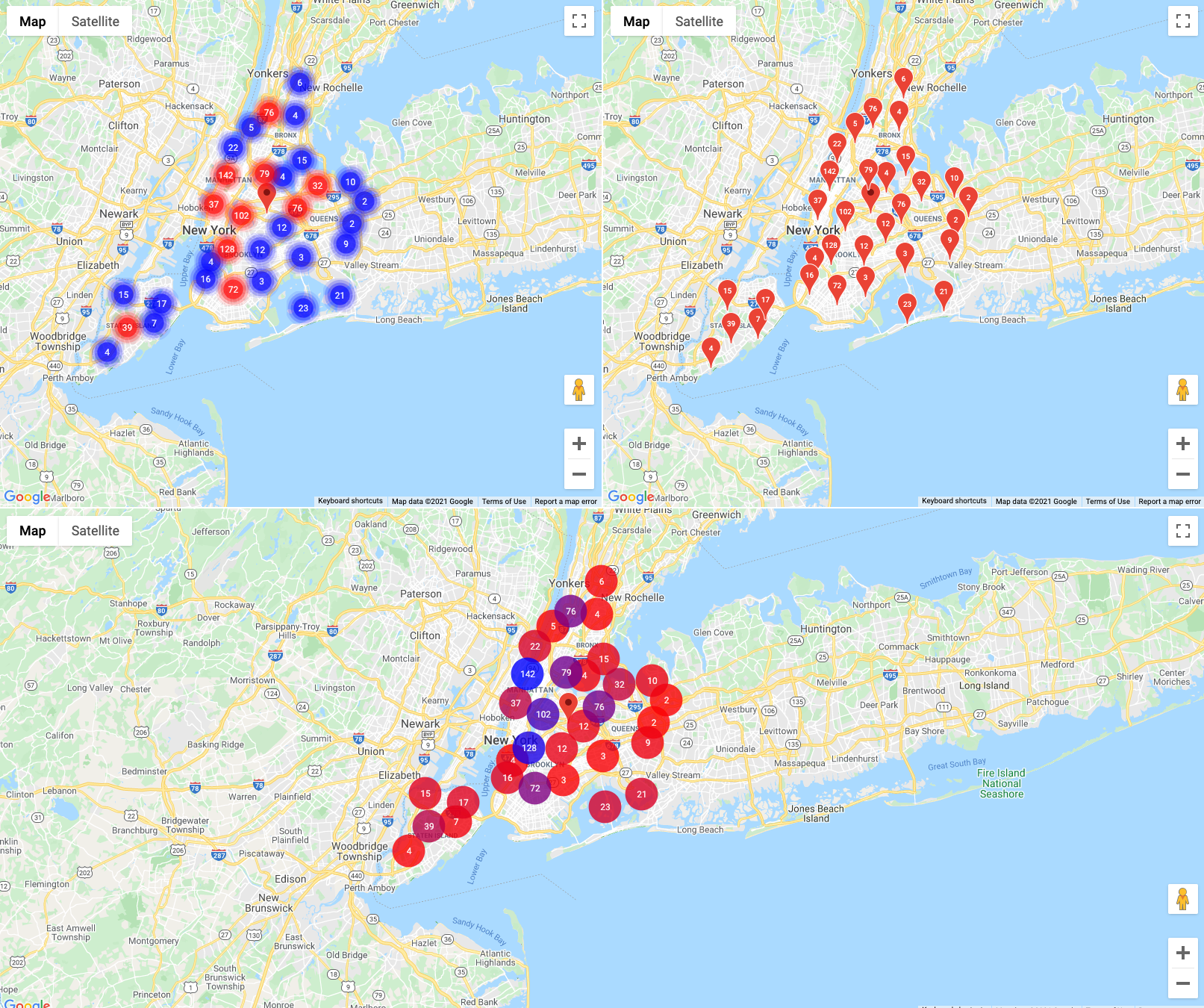
Research
/Security News
Weaponizing Discord for Command and Control Across npm, PyPI, and RubyGems.org
Socket researchers uncover how threat actors weaponize Discord across the npm, PyPI, and RubyGems ecosystems to exfiltrate sensitive data.
@googlemaps/markerclusterer
Advanced tools
Creates and manages per-zoom-level clusters for large amounts of markers.
The library creates and manages per-zoom-level clusters for large amounts of markers.

See the history section and migration section for how this library relates to @google/markerclusterer and @googlemaps/markerclustererplus.
Install the @googlemaps/markerclusterer NPM package with:
npm i @googlemaps/markerclusterer
Alternativly you may add the umd package directly to the html document using the unpkg link.
<script src="https://unpkg.com/@googlemaps/markerclusterer/dist/index.min.js"></script>
When adding via unpkg, the MarkerClusterer can be accessed at markerClusterer.MarkerClusterer.
This library uses the official TypeScript typings for Google Maps Platform, @types/google.maps.
npm i -D @types/google.maps
The documentation is generated from the TypeScript definitions.
import { MarkerClusterer } from "@googlemaps/markerclusterer";
// use default algorithm and renderer
const markerCluster = new MarkerClusterer({ map, markers });
To run the examples:
npm installnpm run devExamples details:
Algorithm Comparisons - This example demonstrates the different algorithms. Please note that spacing and many other options can be changed for each algorithm.
Renderer Usage - This example demonstrates different renderers similar to the image below.

This library has a heritage in @google/markerclusterer and @googlemaps/markerclustererplus, originally made available on code.google.com and then transferred to GitHub at https://github.com/googlemaps/v3-utility-library. The following is an approximate timeline.
The API of [@googlemaps/markerclusterer][@googlemaps/markerclusterer] has changed in a number of ways from @googlemaps/markerclustererplus.
MarkerClusterer class now accepts an algorithm and renderer parameter to allow for more flexibility. The interface looks like the following:{
algorithm?: Algorithm;
map?: google.maps.Map;
markers?: google.maps.Marker[];
renderer?: Renderer;
onClusterClick?: onClusterClickHandler;
}
MarkerClusterer accepts a single options argument instead of positional parameters.GridAlgorithm is still supported, but is not the default. The default is supercluster which uses k-d trees for improved performance.MarkerClusterer class is still an instance of google.maps.OverlayView, but uses google.maps.Markers instead of google.maps.Overlay to render the clusters. This solves issues related to the usage of map panes and click handlers.Contributions are welcome and encouraged! If you'd like to contribute, send us a pull request and refer to our code of conduct and contributing guide.
This library uses Google Maps Platform services. Use of Google Maps Platform services through this library is subject to the Google Maps Platform Terms of Service.
This library is not a Google Maps Platform Core Service. Therefore, the Google Maps Platform Terms of Service (e.g. Technical Support Services, Service Level Agreements, and Deprecation Policy) do not apply to the code in this library.
If your billing address is in the European Economic Area, effective on 8 July 2025, the Google Maps Platform EEA Terms of Service will apply to your use of the Services. Functionality varies by region. Learn more.
This library is offered via an open source license. It is not governed by the Google Maps Platform Support [Technical Support Services Guidelines, the SLA, or the Deprecation Policy. However, any Google Maps Platform services used by the library remain subject to the Google Maps Platform Terms of Service.
This library adheres to semantic versioning to indicate when backwards-incompatible changes are introduced. Accordingly, while the library is in version 0.x, backwards-incompatible changes may be introduced at any time.
If you find a bug, or have a feature request, please file an issue on GitHub. If you would like to get answers to technical questions from other Google Maps Platform developers, ask through one of our developer community channels. If you'd like to contribute, please check the contributing guide.
You can also discuss this library on our Discord server.
2.6.2 (2025-07-08)
leaflet.markercluster is a popular plugin for the Leaflet library that provides similar functionality for clustering markers on a map. It offers a variety of customization options and is widely used in the Leaflet community. Compared to @googlemaps/markerclusterer, it is designed specifically for Leaflet maps rather than Google Maps.
supercluster is a fast, geospatial point clustering library for browsers and Node. It is highly efficient and can handle large datasets. Unlike @googlemaps/markerclusterer, supercluster is not tied to any specific mapping library and can be used with various mapping solutions.
FAQs
Creates and manages per-zoom-level clusters for large amounts of markers.
The npm package @googlemaps/markerclusterer receives a total of 956,242 weekly downloads. As such, @googlemaps/markerclusterer popularity was classified as popular.
We found that @googlemaps/markerclusterer demonstrated a healthy version release cadence and project activity because the last version was released less than a year ago. It has 4 open source maintainers collaborating on the project.
Did you know?

Socket for GitHub automatically highlights issues in each pull request and monitors the health of all your open source dependencies. Discover the contents of your packages and block harmful activity before you install or update your dependencies.

Research
/Security News
Socket researchers uncover how threat actors weaponize Discord across the npm, PyPI, and RubyGems ecosystems to exfiltrate sensitive data.

Security News
Socket now integrates with Bun 1.3’s Security Scanner API to block risky packages at install time and enforce your organization’s policies in local dev and CI.

Research
The Socket Threat Research Team is tracking weekly intrusions into the npm registry that follow a repeatable adversarial playbook used by North Korean state-sponsored actors.